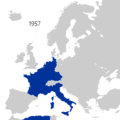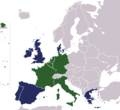European Economic Community facts for kids
The European Economic Community (EEC) was an important group of countries in Europe. It was created to help these countries work together, especially on trade and money matters. Think of it as an early version of the European Union (EU) that we know today. The EEC existed from 1957 until 1992, when it became part of the European Union through the Treaty of Maastricht.
Contents
What was the European Economic Community?
The European Economic Community, or EEC, was a special club of European countries. Its main goal was to bring peace and prosperity to Europe after World War II. The idea was that if countries traded and worked closely together, they would be less likely to fight. The EEC focused on making it easier for goods, services, money, and people to move freely between member countries.
A Fresh Start for Europe
The EEC officially started in 1957 with the signing of the Treaty of Rome. Six countries were the first members:
- Belgium
- France
- Italy
- Luxembourg
- The Netherlands
- West Germany
These countries wanted to build a stronger, more peaceful future together. They believed that by sharing their economies, they could prevent future conflicts and help everyone become richer.
Working Together: The EEC's Goals
The EEC had several big goals:
- Common Market: This meant creating one big market where goods could be bought and sold without extra taxes or difficulties at borders. It was like turning many small markets into one giant supermarket.
- Common Policies: Members agreed to work together on things like farming and trade with countries outside the EEC. This helped ensure fair prices for farmers and a united front in global trade.
- Economic Growth: By working together, countries hoped to boost their economies, create more jobs, and improve living standards for everyone.
How the EEC Grew Over Time
Over the years, more countries decided to join the EEC. This showed that the idea of working together was popular and successful.
- In 1973, Denmark, Ireland, and the United Kingdom joined.
- Greece joined in 1981.
- Spain and Portugal joined in 1986.
Each new member helped the EEC grow stronger and more influential on the world stage. The European Parliament also started holding direct elections in 1979, giving citizens more say in how the Community was run.
From EEC to European Union
The EEC was very successful, but leaders wanted to do even more than just economic cooperation. They wanted closer political ties, a common foreign policy, and even a single currency. This led to the signing of the Treaty of Maastricht in 1992. This treaty created the European Union (EU), which took over from the EEC in 1993. The EU continued the work of the EEC but added new areas of cooperation, making it a much broader and deeper partnership between European nations.
Images for kids
-
French President Charles de Gaulle vetoed British membership, held back the development of Parliament's powers and was at the centre of the 'empty chair crisis' of 1965
-
President Jacques Delors the last EEC Commission President.
-
The European Parliament held its first elections in 1979, slowly gaining more influence over Community decision making.
See also
 In Spanish: Comunidad Económica Europea para niños
In Spanish: Comunidad Económica Europea para niños







